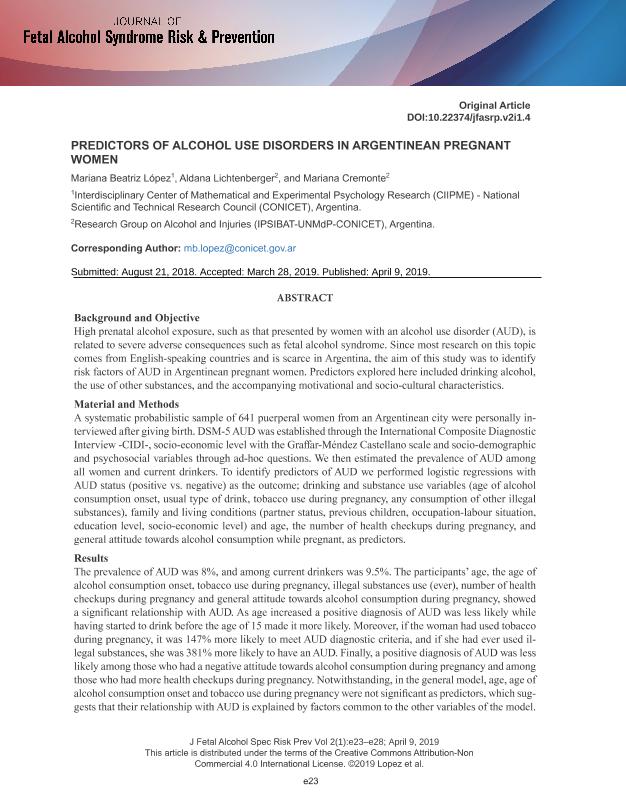Artículo
Predictors of alcohol use disorders in argentinean pregnant women
Fecha de publicación:
01/2019
Editorial:
Dougmar Press
Revista:
Journal of Fetal Alcohol Spectrum Risk and Prevention
ISSN:
2561-9187
Idioma:
Inglés
Tipo de recurso:
Artículo publicado
Clasificación temática:
Resumen
Background and Objective High prenatal alcohol exposure, such as that presented by women with an alcohol use disorder (AUD), is related to severe adverse consequences such as fetal alcohol syndrome. Since most research on this topic comes from english speaking countries and is scarce in the Argentina, the aim of this study was to identify risk factors of AUD in Argentinean pregnant women. Predictors explored here included drinking alcohol, the use of other substances, and their accompanying motivational and socio-cultural characteristics. Material and Methods A systematic probabilistic sample of 641 puerperal women from an Argentinean city were personally interviewed after giving birth. DSM-5 AUD was established through the International Composite Diagnostic Interview -CIDI-, socio-economic level with the Graffar-Méndez Castellano scale and socio-demographic and psycho-social variables through ad-hoc questions. We then estimated the prevalence of AUD among all women and current drinkers. To identify predictors of AUD we performed logistic regressions with AUD status (positive vs. negative) as the outcome; drinking and substance use variables (age of alcohol consumption on set, usual type of drink, tobacco use during pregnancy, any consumption of other illegal substances), family and living conditions (partner status, previous children, occupation-labor situation, education level, socioeconomic level) and age, the number of health checkups during pregnancy, and general attitude towards alcohol consumption while pregnant, as predictors. ResultsThe prevalence of AUD was 8%, and among current drinkers was 9.5%. The participants age, age of alcohol consumption onset, tobacco use during pregnancy, illegal substances use (ever), number of health checkups during pregnancy and general attitude towards alcohol consumption during pregnancy, showed a significant relationship with AUD. As age increased a positive diagnosis of AUD was less likely, while having started to drink before the age of 15 made it more likely. Moreover, if the woman had used tobacco during pregnancy, it was 147% more likely to meet AUD diagnostic criteria, and if she had ever used illegal substances, she was 381% more likely to have an AUD. Finally, a positive diagnosis of AUD was less likely among those who had a negative attitude towards alcohol consumption during pregnancy and among those who had more health checkups during pregnancy. Notwithstanding, in the general model, age, age of alcohol consumption onset and tobacco use during pregnancy were not significant as predictors, which suggests that their relationship with AUD is explained by factors common to the other variables of the model. Conclusion urgent action is needed in the region to prevent prenatal drinking, and pregnant women with an AUD should be the focus of distinct efforts. Interventions should target younger women, those who consume or have consumed illegal substances and those who maintain a more permissive attitude towards alcohol consumption during pregnancy.
Palabras clave:
WOMEN
,
ETHANOL
,
ALCOHOLICS
,
RISK FACTORS
,
PREGNANCY
Archivos asociados
Licencia
Identificadores
Colecciones
Articulos(CIIPME)
Articulos de CENTRO INTER. DE INV. EN PSICOLOGIA MATEMATICA Y EXP. "DR. HORACIO J.A RIMOLDI"
Articulos de CENTRO INTER. DE INV. EN PSICOLOGIA MATEMATICA Y EXP. "DR. HORACIO J.A RIMOLDI"
Citación
López, Mariana Beatríz; Lichtenberger, Aldana; Cremonte, Mariana; Predictors of alcohol use disorders in argentinean pregnant women; Dougmar Press; Journal of Fetal Alcohol Spectrum Risk and Prevention; 2; 1; 1-2019; 23-28
Compartir
Altmétricas




